The Intel 6th Gen Skylake Review: Core i7-6700K and i5-6600K Tested
by Ian Cutress on August 5, 2015 8:00 AM ESTWhat You Can Buy: Linux Performance
Built around several freely available benchmarks for Linux, Linux-Bench is a project spearheaded by Patrick at ServeTheHome to streamline about a dozen of these tests in a single neat package run via a set of three commands using an Ubuntu 11.04 LiveCD. These tests include fluid dynamics used by NASA, ray-tracing, OpenSSL, molecular modeling, and a scalable data structure server for web deployments. We run Linux-Bench and have chosen to report a select few of the tests that rely on CPU and DRAM speed.
C-Ray: link
C-Ray is a simple ray-tracing program that focuses almost exclusively on processor performance rather than DRAM access. The test in Linux-Bench renders a heavy complex scene offering a large scalable scenario.
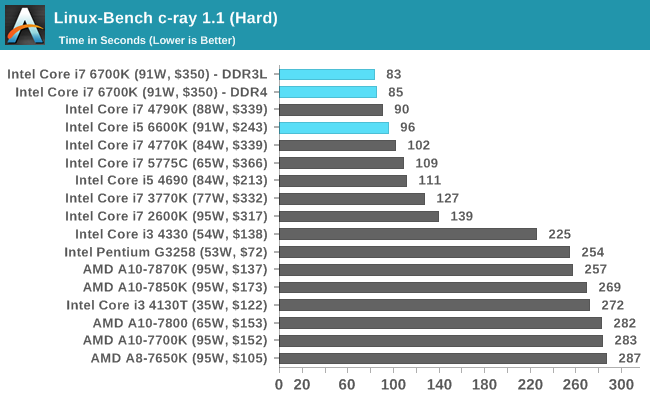
NAMD, Scalable Molecular Dynamics: link
Developed by the Theoretical and Computational Biophysics Group at the University of Illinois at Urbana-Champaign, NAMD is a set of parallel molecular dynamics codes for extreme parallelization up to and beyond 200,000 cores. The reference paper detailing NAMD has over 4000 citations, and our testing runs a small simulation where the calculation steps per unit time is the output vector.
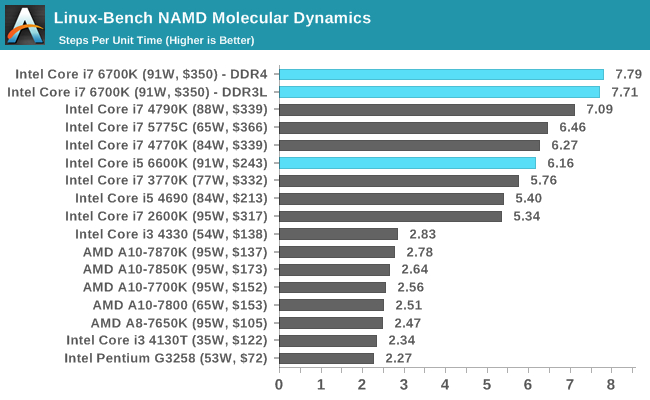
NPB, Fluid Dynamics: link
Aside from LINPACK, there are many other ways to benchmark supercomputers in terms of how effective they are for various types of mathematical processes. The NAS Parallel Benchmarks (NPB) are a set of small programs originally designed for NASA to test their supercomputers in terms of fluid dynamics simulations, useful for airflow reactions and design.
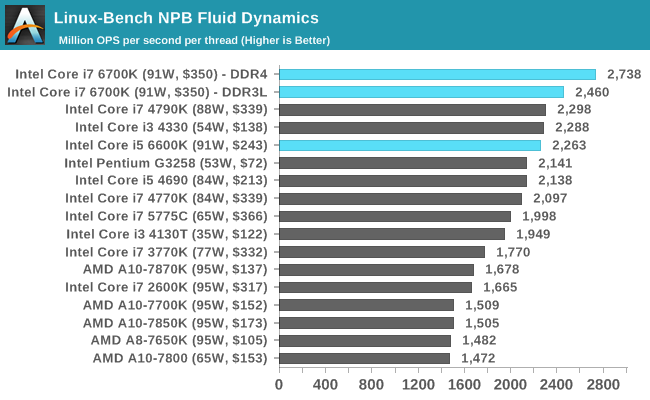
Redis: link
Many of the online applications rely on key-value caches and data structure servers to operate. Redis is an open-source, scalable web technology with a b developer base, but also relies heavily on memory bandwidth as well as CPU performance.
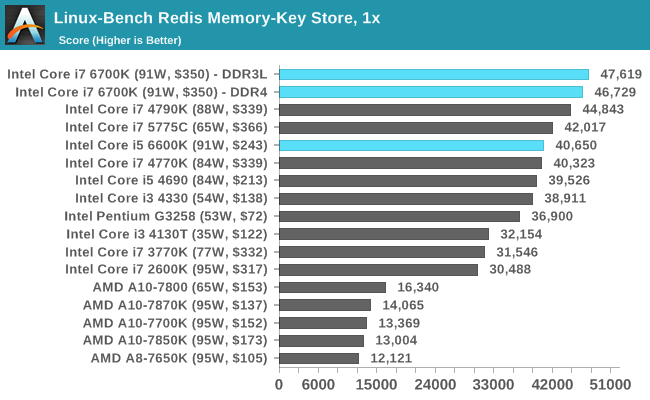
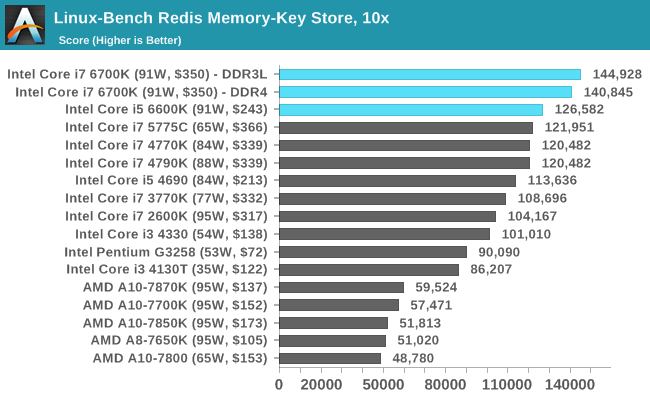
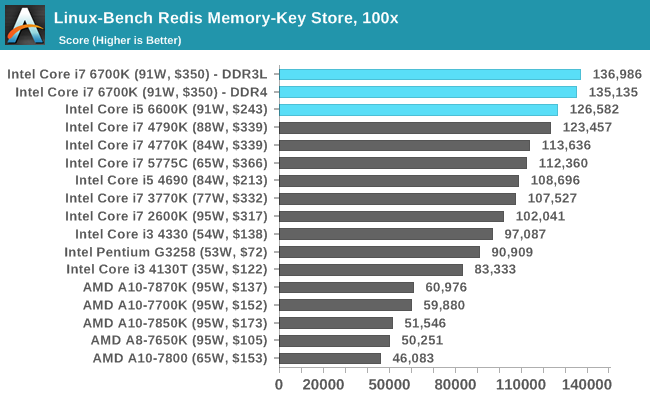










477 Comments
View All Comments
asmian - Sunday, August 9, 2015 - link
>Somehow I doubt it...Sorry, no edit - I meant of course the reverse, that 2 extra cores is DEFINITELY better than marginal extra IPC at a slightly higher overclock, despite the slightly higher TDP. Quad-core Skylake at this price AND requiring DDR4 makes Haswell-E look very good indeed.
Ethos Evoss - Sunday, August 9, 2015 - link
Why they STILL calling it i7 an i5 i3 ... they supposed to change it this time differently ..like i4 i6 i8 ?? or rather without that apples ''i'' ?
orion23 - Sunday, August 9, 2015 - link
Yay for my 2600K @ 4.8ghz from day 1Never had as much fun overclocking and building system
By now, I've changed cases (3x) and PSU's (2X), VGA's (2X). But not my loyal 2600K :)
What a workhorse it is
Kutark - Sunday, August 9, 2015 - link
I think a lot of people in the comments aren't really understanding the article. They state that the best reason to upgrade isn't really the processor speed, its all the other things the new platform affords you.In particular im very happy that i will FINALLY be able to get an SSD with speeds faster than what SATA3 allows as many of the motherboard for the z170 have m.2 thats not running on sata but on PCIE channels. It also allows for some real bandwidth in SLI situations. I have a single 980ti, and this platform would allow me to SLI another down the road and not impede things.
Granted, its not a good value proposition when you look at the end result, but its a very nice future proofing platform in my opinion.
Its kind of like saying if you have a modded older mustang thats as quick as a new mustang that you shouldn't upgrade because its just as or maybe slightly faster. There are more factors to the equation. Things that add to the quality of life, etc.
In skylake's its mostly stuff related to the chipset. IMO thas fine by me.
sonny73n - Wednesday, August 12, 2015 - link
I think you're an idiot. Understanding the article is one thing, realizing how close it is to the truth is another. Sure it's a nice upgrade for anything prior to Sandy Bridge but the author has summed up this article with a bold statement "Sandy Bridge, Your Time Is Up" which I believe - a false statement. Should I have a 5th grader break down the calculation of upgrade options so you can understand? First, note to mind that there's no such thing as future proofing in PC hardwares like you said and K series are made for overclocking.Let break down the upgrade options for my rig - Z68 MB $190, 2500K $230, HSF $60, 8GB RAM $60, PSU $180, GTX 780 $480, SSD $180, Case $80. Total $1460.
Option 1: Upgrade MB, CPU, HSF and RAM. Old components ($540 new) can eBay for ~$200. New components $560 - $200 = $360 (out of pocket). Performance gain: System Overall 30%, Gaming 3 to 5%.
Option 2: Upgrade the whole system. Total $1480. Performance gain same as option 1. Now having 2 systems (wonder what I'm gonna do with both).
Option 3: Upgrade for gaming. Another GTX 780. Performance gain: BF3 1920x1200 4xAA about 95%. Total $480.
Sure Skylake has some new features. Do I need them? NO. Do my SSD saturate SATA3 bus (throughput around 550MB/s)? NO. Is there any program (beside Handbrake which I use rarely) that can utilize the full power of my 2500K OCed mildly at 4.2GHz? NO. Can 980ti SLI saturate PCI-e2.0? NO. Am I such an idiot that I have a good running Mustang but I still like to buy another just because it's a bit better? NO. Is being financially irresponsible add to the quality of life? NO.
Anyone with a brain that has a SB system or newer would never pick the first 2 options.
mapesdhs - Wednesday, August 12, 2015 - link
If there was a thumbs-up button for your post, I'd be clicking it. :Dsonny73n - Thursday, August 13, 2015 - link
Thanks :-) I wish I could explain it better. He's probably wondering why there's a $20 different lol. Hint CPUKutark - Thursday, August 20, 2015 - link
This is pretty hilarious and just further proves my point. You had a fundamental misunderstanding of what the article is stating. You also have a fundamental understanding of the concept of an opinion. This article is not a encyclopedia brittanica article trying to create statements of fact. It is the OPINION of this website that sandy bridge's time is up. I tend to agree with them. And i'm on sandy bridge.Like most internet heroes, you're focusing on one aspect, price/performance. People buy products for a multitude of other reasons. Just simply getting a pure speed upgrade isn't always the primary factor behind the decision.
For example, i bought a VW GTI a few years back instead of a Mazdaspeed 3, even though the mazdaspeed 3 was a better performing car, and was cheaper. I bought the VW because of the intangibles. I liked the way it drove, i liked the interior design better, the exterior design better, etc etc etc.
I will be buying a skylake platform because i like the options the chipset affords me moving forward, in particular the increased number of PCI express lanes which will come in useful when m.2 pcie SSD's come down in price.
And please don't talk to me about financial responsibility. We're not talking about buying a $500k house when you can really only afford a $300k house. Most of us make enough money that while $1k isn't insignificant, it's not going to break the bank either. Get your head out of your ass.
But, please, continue on making an ass of yourself, if nothing it is entertaining...
FullCircle - Monday, August 10, 2015 - link
I'm still happy with my SandyBridge i7-2600k.I see no reason to upgrade for 25% performance boost...
I just upgraded my graphics card from GTX 580 to GTX 970, giving me a performance boost of 250%... now that's a worthwhile upgrade...
25% on the other hand? That's not worth it. CPU advancement has slowed so much there's not much reason to upgrade at the moment unless you have an incredibly old processor. Even the Core i7 processor I have in my old PC is still pretty good.
mapesdhs - Wednesday, August 12, 2015 - link
I upgraded from 3GB 580 SLI to one 980 and even that was a good speed increase. Rocking along with a 5GHz 2700K. For a 2nd system to drive a 48" TV, I considered HW, but in the end for the games I'll be playing (which can use more than 4 cores) a used SB-E build made a lot more sense. ASUS R4E only 113 UKP, 3930K only 185 UKP, etc. Only key item I bought new was another 980.It's pretty obvious with hindsight that Intel jumped ahead much more than they needed to with SB/SB-E, so we won't see another leap of that kind again unless AMD or some other corp can seriously compete once more, just as AMD managed to do with Athlon64 back in the day. All this stuff about bad paste under the heat spreaders of IB, HW and still with SL proves Intel is dragging its feet, ditto how lame the 5960X compares to XEONs wrt its low clock, TDP, etc. They could make better, but they don't need to. Likewise the meddling with the PCIe lanes for HW-E; it's crazy that a 4820K could actually be better than a 5820K in some cases. Should have been the other way round: 5820K should have been the 6-core low end with 40 lanes, next chip up at current 5930K pricing should have been an 8-core with 40 lanes, 5960X should have been an 8 or 10 core with 64 or 80 lanes (whatever), with a good 3.5 base clock, priced *above* the current 5960X a tad - that would have been a chip the real enthusiasts with money to burn would have bought, not the clock-crippled 5960X we have atm.